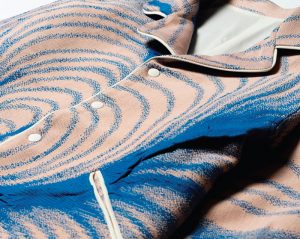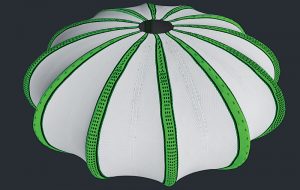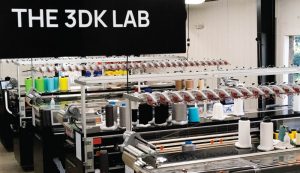
3D sampling is an environmentally friendly way of reducing lead times and waste in the apparel industry.
By Garrett Gerson
The inexorable momentum of 3D digital sampling is reshaping the landscape of the textile industry, charting the trajectory toward an inevitable future. As the paradigm shift gains acceleration, enterprises find themselves at a crossroads, where prudent choices not only economize resources and time but also demonstrate a commitment to ecological responsibility in the face of climate imperatives. Overall, 3D digital design is a more efficient and lower-impact way of designing and prototyping not just clothing but textiles in general. For the apparel industry, it is critical to move forward. Simply put, the benefits of using 3D digital renderings, when integrated into the design process, yield dramatic results and play a major role in facilitating and reducing material waste.
What Is 3D Digital Sampling?
Technological advancements and the adoption of 3D models have been prominent in manufacturing and engineering industries for decades, working with products such as furniture, automobiles, computer chips, planes and more. Yet 3D technology only recently has been adopted by the apparel industry as more benefits of its use are coming to light.
In the world of fashion design and clothing production, samples play a crucial role in the development process. However, the traditional method of prototyping and sampling is time-consuming and damaging to the environment. Physical samples can take weeks or even months to produce and require the use of materials and labor. In contrast, digital samples reduce the design approval time from weeks to hours.
The 3D clothing sampling process digitizes, corrects, and plots the pattern faster than manual setups. No water or chemicals are used for the creation or usage of digital fashion. The production of a digital garment, on average, generates 97-percent less carbon dioxide and no microplastic shedding or soil degradation compared to the production of a physical garment, according to the United Nations Alliance for Sustainable Fashion.
Over the past five years, lead times for garment production have shrunk in half. Yet traditional sampling methods have stayed the same, slowing the process and stretching teams. What’s more, 40 percent of sampling does not move forward in production, which is why traditional methods of sampling are a major source of waste in the garment industry.
3D software capabilities allow designers to create virtual clothing with different materials and textures, providing them with a realistic representation of how the final product will look. In turn, designers can experiment with various fabrics and patterns before committing to a particular layout and see how their designs will appear on a model before producing the garment, all while reducing waste and saving time in the process.
This review process helps to identify any design flaws or issues with the fabric, such as how it drapes on the body. Designers can also explore end-less color combinations by using a Pantone color bank or similar online shade bank in their 3D designs. It allows them to make accurate decisions before creating a final physical product. By making these adjustments before producing garments, costly mistakes can be avoided.

Advantages Of Virtual Sampling Technology
With features like real-time updates, virtual reality presentations, and drag-and-drop model creation, 3D sampling technology is pioneering a more efficient and environmentally conscious way of producing textiles. It’s evident textiles are pervasive in our lives, from automotive interiors to everyday clothing and footwear. The latest 3D digital sampling software advancements reshape the textile industry by expediting prototyping and enabling localized production, resulting in substantial waste reduction and minimized carbon footprints.
The advantages of incorporating virtual samples and digital twins into textile development are profound. By leveraging features such as real-time updates, immersive virtual reality presentations, and intuitive drag-and-drop model creation, 3D sampling technology is at the forefront of an efficient and environmentally conscientious textile production approach.
For suppliers and vendors, the ability to digitally review designs, even remotely, eliminates the necessity for global sample creation and shipping. Iterations for color, fabric, and shape adjustments can seamlessly occur online. This technology also streamlines content production, circumventing the need for teams to travel to various locations to photograph new collections.
Furthermore, emerging technologies like the Metaverse and augmented reality (AR) are revolutionizing how clothing items are accessed online. This simplifies the decision-making process for buyers, enabling them to make informed choices without physical representation. Consequently, manufacturers can curtail excessive production, aligning output more accurately with consumer demand. This confluence of virtual sampling and innovative technologies ushers in a new era of efficiency and enhanced customer experience within the textile industry.
CAD/CAM software is being used to design textile products and manufacture prototypes. For example, VARIANT3D has developed LOOP™, a web-based platform for the collaborative design of 3D knitted fabrics and products. It offers a hyper-realistic preview of the knitted fabric, providing designers and engineers with a clear preproduction simulation prior to committing to a sample. Another 3D software company in the field of fashion design is CLO. It has created a true-to-life garment visualization pro-gram that allows users to perfect their ideas before they go into cut-and-sew production. These emerging technologies result in a waste-reduced production process.
Often, garments require corrections or adjustments which involve a new version of the product to be cut, sewn, and shipped to the buyer. Virtual sampling takes care of any necessary changes that need to be made before the garment is sewn, saving on fabric costs, shipping costs, as well as fit-model costs.
Reducing Waste With Digital Sampling
Did you know that the fashion industry is the second-largest consumer of water in the world? This is because many clothes are cotton-based, a very water-intensive plant. “The apparel industry uses enough fresh water to quench the thirst of five million people a year, produces 20 percent of global wastewater, and has a carbon intensity that exceeds aviation and shipping combined,” Morgan Stanley analysts wrote in a May 2022 report on the sector.
Some 85 percent of clothing made ends up in landfills each year, and 25 percent of those are samples that will never be seen more than once or twice. According to the EPA, landfills receive 11.3 million tons of textile waste annually. To minimize the adverse environmental impacts of production, brands must consider alternatives to traditional sampling methods.
Many brands currently using digital sampling ask for just one “top” physical sample before launching production, while some have done away with physical samples altogether. This dramatically reduces wasted fabric and eliminates the unnecessary logistics of getting the samples between the factory and designers, as well as reducing the time and costs involved: good news for businesses and the planet.

What Does 3D Virtual Sampling Mean For Businesses & The Environment?
The push toward replacing physical samples with 3D samples stems from several driving factors. Recent supply chain disruptions illustrated how quickly best-laid plans can go awry. Additionally, challenged by the swing toward remote working, brands need a new approach.
Furthermore, the turnaround time to make and receive physical fabric samples — just to eliminate or change designs completely — is incredibly inefficient. The fashion industry has to react quickly when consumers are ready to spend. It’s not sensible to spend weeks spinning, programming, weaving/knitting, cutting, sewing, and shipping samples back and forth before production can even begin.
The visuals generated from the 3D simulations also are used to drive marketing and e-commerce. Marketing teams can showcase all the variations of a collection, and brands can easily see a photo-realistic version of product variations, eliminating the need for photo shoots. Brands can easily promote products through their website or social media channels, and customers can purchase them before physical products are produced.
3D technology can create virtual samples of an upcoming collection, which can be sent to buyers anywhere, with a much lower carbon footprint. The fashion industry is starting to make more environmentally conscious decisions, from materials choices, manufacturing processes, and the recycling of products at the end of their life cycle. The key feature in implementing all these processes? Technology.
The use of 3D software changes the design process and associated methodologies and permits better and faster communication among different departments and professionals. Importantly, digitally-driven whole-sale activities can track and archive the interactions between brands and buyers. The resulting data analytics and metrics provide valuable insights for developing customized and collaborative digital collections.
The application of 3D technologies allows for the optimization of digital made-to-measure and on-demand generation — swinging the balance of production back onshore to locally-based microfactories. This change is paramount.
Brands such as Under Armour, Coach, Victoria’s Secret, Hugo Boss, Maggy London, Phillip Van Heusen, Nike, Abercrombie & Fitch, and others already are using 3D virtual sampling technologies, with many more brands expected to do so in the near future.
Consumer Influence
Consumers invariably influence the fashion industry. Right now, they are demanding a paradigm shift to sustainable manufacturing, ethical practices and transparency being the standard. According to Heuritech Data, the social media hashtag #sustainablefashion, has skyrocketed in popularity, up 1,000 percent since 2018. The fashion industry is finally listening and is transitioning to this new standard to satisfy customers and earn their trust.
According to the Global Fashion Market Place sustainability report, 82 percent of brands believe that they need sustainable business development and innovation support. This transformation is neither simple nor quick to implement, and fashion brands have realized that marketing and vague statements are not enough, as consumers will call them out for greenwashing.
As for consumers, the pandemic accelerated their familiarity with digital platforms, virtual reality, and augmented reality tools. Increased digitization will be central to the post-pandemic future of fashion. This shift is happening, and brands must explore the opportunities to digitize their sampling processes now or risk being left behind.
With a rising number of returns and landfill waste, the fashion industry desperately needs technologies to help address poor fit. Recently, Google launched new artificial intelligence software that takes a clothing image and reflects how it drapes, folds, clings, and stretches on a diverse set of real models in various poses. In the fashion retail space, several fashion companies, including Macy’s and luxury brands like Louis Vuitton and Dior, are exploring the potential of AR clothing try-on technology.
What’s Next?
Embracing digital technology is a fundamental way to stop wasteful behaviors in the larger textile industry. As consumers grow more environmentally conscious, some of the most popular brands are moving away from the inefficient methods of the past and adopting new technology to help bring about significant improvements.
3D sampling is a vital tool in transforming the industry in endless ways. From design to production and marketing, it is enabling processes to become more efficient, considered, and customer-focused. It can positively impact all facets of the supply chain when implemented correctly.
As 3D technology continues to advance, it will redefine the future of the textile industry.
Editor’s Note: Garrett Gerson is the founder and CEO of VARIANT3D, a Malibu, Calif.-based company that offers rapid prototyping and product iteration for 3D knitted products.
March/April 2024




